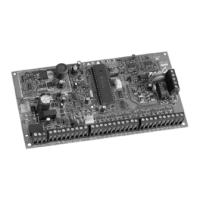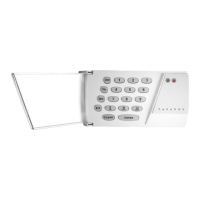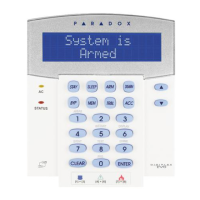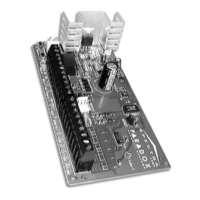16
Panel "A" Partition Zones "B" Partition Zones Total Possible Zones
748, 748ES
1-6, 13-18, 13 = (Keypad 1) 7-12, 19-24, 19 = (Keypad 2) 24
738
1-6, 13(Keypad 1) 7-12, 19 (Keypad 2) 14
728
1-6 (See note) 7 (Keypad 1), 8 (Keypad 2) 8
Notes re:
728
(also see page 27)
The designation for zones 1, 2, 3,4,5 and 6 can be changed to zones 7, 8, 9,10,11 and 12
respectively so that they form part of partition “B”.
Zones 1 and 2 will be swapped with zones 7 and 8.
Note: When partitioning is not activated (address 206, key [8] "off") any zones selected at addresses
240 and 242 will be armed upon "stay" arming.
Keypad display:
Both systems are displayed on the keypad at the same time. In partitioning mode, when System "A" is
armed, the [STAY] key flashes. If System "B" is armed, the [AWAY] key flashes. If both systems are armed,
both of these keys will flash.
ARMING/DISARMING
Code definition:
Partition "on" (Address 206, key [8] "on")
Address 200: Designates access codes that arm System "A" zones.
Address 202: Designates access codes that arm System "B" zones.
Address 204: Designates access codes that can "bypass" zones
When a code is activated at both addresses (200 and 202), it can do the following:
1) The code can fully arm the system. If the code is entered when systems "A" and "B" are
disarmed, it will completely arm the system.
2) The code can fully disarm the system. If the code is entered when system "A" and "B" zones
are armed, it will completely disarm the system.
3) When the system is partially armed (i.e. only System "A" or "B" is armed) entering this code will
arm the other system.
4) The code can be used to selectively arm/disarm System "A" or System "B" zones.
Enter [11] + code to arm/disarm System "A" zones.
Enter [12] + code to arm/disarm System "B" zones.
Note: Codes that are not selected at either address are disabled.
The master code can always access both systems and bypass zones.
(1) System "A" codes can stop sirens coming from System "B" zones (and vice versa), but will not
disarm the other system.
(2) It is not possible to arm one system during the other system's exit delay.
Note: When partitioning is not activated, (address 206, key [8] "off"):
Address 200 determines which access codes can activate "stay" arming.
Address 202 determines which access codes can activate "away" arming.
Address 204 determines which access codes can "bypass" zones.
IM8
